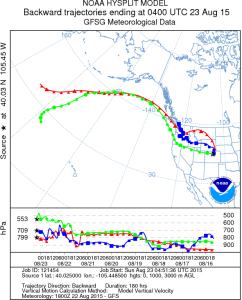The Colorado Mountains are famous for their opal blue sky and seemingly unlimited visibility. Even in the Front Range where the air quality is often not as good due in part to its proximity to the Denver Metropolitan Area it is common to be able to see the Front Range Mountains stretching from Pikes Peak to the south to Longs Peak to the north – a distance of over 80 miles.
So, what’s up with the haze that has beset the region over the past few days? This is primarily the result of the wildfires which are burning in the Pacific Northwest and Northern California. While this may seem like a long distance for smoke from these fires to travel, the particles which make up smoke are small enough to be carried these long distances by the winds in the mid to upper levels of the atmosphere. Some residents here Nederland claim to even be able to smell the smoke. NOAA provides a tool which allows meteorologists to analyze where air travels over a period of time, something called a trajectory. Air moves in three dimensions, meaning that it can rise and fall as it moves from one area to another. This tool, called the HySplit Model, can be used to forecast where a plume of smoke or other materials will travel, allowing forecasters to alert residents who may be in the path of it. It also allows forecasters to determine where air has traveled from.
Here is a trajectory I generated this evening using the HySplit Model. It shows where the air in the Nederland area this evening has traveled from over the past several days, going back to Sunday, August 16th. Notice that this air has passed over Washington and Oregon, the locations of some of the fiercest, most widespread wildfires. In fact, the smoke we are experiencing now originated from these fires about two days ago.

Tools like this give us a better understanding of how air masses move and where the air we are breathing now came from.